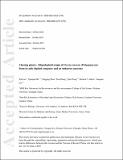Files in this item
Chasing ghosts : allopolyploid origin of Oxyria sinensis (Polygonaceae) from its only diploid congener and an unknown ancestor
Item metadata
| dc.contributor.author | Luo, Xin | |
| dc.contributor.author | Hu, Quanjun | |
| dc.contributor.author | Zhou, Pingping | |
| dc.contributor.author | Zhang, Dan | |
| dc.contributor.author | Wang, Qian | |
| dc.contributor.author | Abbott, Richard J. | |
| dc.contributor.author | Liu, Jianquan | |
| dc.date.accessioned | 2018-04-01T23:34:51Z | |
| dc.date.available | 2018-04-01T23:34:51Z | |
| dc.date.issued | 2017-06 | |
| dc.identifier | 249386798 | |
| dc.identifier | 39cdaf26-504f-49e5-9c50-9046defa58f1 | |
| dc.identifier | 85017161572 | |
| dc.identifier | 000402040000016 | |
| dc.identifier.citation | Luo , X , Hu , Q , Zhou , P , Zhang , D , Wang , Q , Abbott , R J & Liu , J 2017 , ' Chasing ghosts : allopolyploid origin of Oxyria sinensis (Polygonaceae) from its only diploid congener and an unknown ancestor ' , Molecular Ecology , vol. 26 , no. 11 , pp. 3037-3049 . https://doi.org/10.1111/mec.14097 | en |
| dc.identifier.issn | 1365-294X | |
| dc.identifier.other | Bibtex: urn:7fac841881061e41aae9fffb018a982f | |
| dc.identifier.uri | https://hdl.handle.net/10023/13055 | |
| dc.description | This work was supported by grants from National Natural Science Foundation of China (31590821), National Key Project for Basic Research (2014CB954100), Ministry of Science and Technology of the People's Republic of China (2010DFA34610) and International Collaboration 111 Projects of China. | en |
| dc.description.abstract | Reconstructing the origin of a polyploid species is particularly challenging when an ancestor has become extinct. Under such circumstances the extinct donor of a genome found in the polyploid may be treated as a ‘ghost’ species in that its prior existence is recognised through the presence of its genome in the polyploid. In this study, we aimed to determine the polyploid origin of Oxyria sinensis (2n=40) for which only one congeneric species is known, i.e. diploid O. digyna (2n=14). Genomic in situ hybridization (GISH), transcriptome, phylogenetic and demographic analyses, and ecological niche modeling were conducted for this purpose. GISH revealed that O. sinensis comprised 14 chromosomes from O. digyna and 26 chromosomes from an unknown ancestor. Transcriptome analysis indicated that following divergence from O. digyna, involving genome duplication around 12 million years ago (Ma), a second genome duplication occurred approximately 6 Ma to give rise to O. sinensis. Oxyria sinensis was shown to contain homologous gene sequences divergent from those present in O. digyna in addition to a set that clustered with those in O. digyna. Coalescent simulations indicated that O. sinensis expanded its distribution approximately 6-7 Ma, possibly following the second polyploidization event, whereas O. digyna expanded its range much later. It was also indicated that the distributions of both species contracted and re-expanded during the Pleistocene climatic oscillations. Ecological niche modeling similarly suggested that both species experienced changes in their distributional ranges in response to Quaternary climatic changes. The extinction of the unknown ‘ghost’ tetraploid species implicated in the origin of O. sinensis could have resulted from superior adaptation of O. sinensis to repeated climatic changes in the region where it now occurs. | |
| dc.format.extent | 13 | |
| dc.format.extent | 604921 | |
| dc.language.iso | eng | |
| dc.relation.ispartof | Molecular Ecology | en |
| dc.subject | Oxyria | en |
| dc.subject | Allopolyploid speciation | en |
| dc.subject | Ghost species | en |
| dc.subject | GISH | en |
| dc.subject | Transcriptome | en |
| dc.subject | Demographic history | en |
| dc.subject | QH301 Biology | en |
| dc.subject | DAS | en |
| dc.subject.lcc | QH301 | en |
| dc.title | Chasing ghosts : allopolyploid origin of Oxyria sinensis (Polygonaceae) from its only diploid congener and an unknown ancestor | en |
| dc.type | Journal article | en |
| dc.contributor.institution | University of St Andrews. School of Biology | en |
| dc.contributor.institution | University of St Andrews. Scottish Oceans Institute | en |
| dc.contributor.institution | University of St Andrews. St Andrews Sustainability Institute | en |
| dc.identifier.doi | https://doi.org/10.1111/mec.14097 | |
| dc.description.status | Peer reviewed | en |
| dc.date.embargoedUntil | 2018-04-01 | |
| dc.identifier.url | http://onlinelibrary.wiley.com/doi/10.1111/mec.14097/full#footer-support-info | en |
This item appears in the following Collection(s)
Items in the St Andrews Research Repository are protected by copyright, with all rights reserved, unless otherwise indicated.

